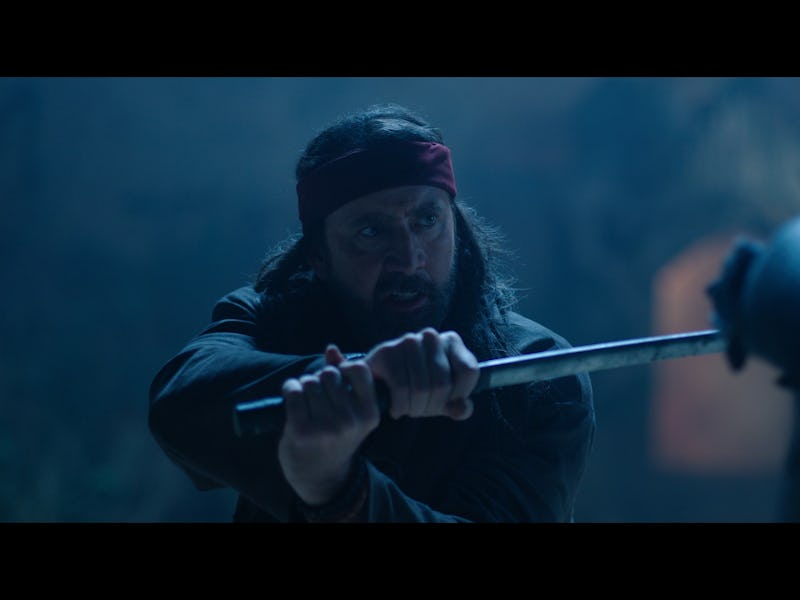Black belt Nicolas Cage was "a consummate artist" in Jiu Jitsu
The Oscar-winning actor did "about 80 percent" of his own stunts in the new sci-fi action movie.

Google the history of jiu jitsu and you won’t find a definitive origin. In recorded history, its beginnings originate in feudal Japan as the unarmed combat of samurai. But before that? No one knows for sure where jiu jitsu came from.
Could be Korea. Could be India. Could be... aliens?
At least, that’s what Dimitri Logothetis, a filmmaker with black belts in disciplines like Tang Soo Do and Kempo, would like you to believe.
“It’s thousands of years old,” Logothetis tells Inverse. “With that nebulous background, I thought it would be perfect to say it was delivered to us by an alien. That was something I thought would work.”
In theaters November 20, Jiu Jitsu is a new sci-fi action movie based on Logothetis’ 2017 comic book. The film stars Alain Moussi (Kickboxer: Vengeance) as Jake Barnes, an amnesiac master martial artist who must grapple with a powerful alien to protect Earth. Supporting Jake is an ancient order of jiu jitsu masters to help him regain his memory, featuring actors like Frank Grillo (Captain America: The Winter Soldier), JuJu Chan (Crouching Tiger, Hidden Dragon), Tony Jaa (The Protector), and... Nicolas Cage.
Yes, that Nicolas Cage, who you may be surprised to know has a black belt in jiu jitsu. The screen legend studied martial arts for years under the guidance of the sport’s royalty, Royce Gracie. That experience came in handy for Cage’s role as the eccentric sage, Wyilie, who doles out the movie’s exposition and throws down in two of the best fight scenes.
Nicolas Cage and Alain Moussi in 'Jiu Jitsu.'
“He’s a consummate artist,” Logothetis says of Cage. “He spent many years training and keeps in good shape. For me to integrate him with my stunt team is very easy. He immediately wanted to work with the team and get right into the physicality.”
Shot and filmed in a tight schedule of one month in Cyprus (in 104 degree temperatures), Logothetis had many concerns about the safety of his crew, Cage included.
“I had to be careful not to let him get hurt,” he says. “He ended up doing an awful lot of [his] martial arts sequences himself. I doubled him only in the areas I thought he would get himself hurt.” In the end, Cage did “about 80 percent” of his stunts himself.
Not all of the martial arts in Jiu Jitsu are, well, jiu jitsu. Practically speaking, an entire movie’s fight choreography can’t all be grapples and submissions — a distinction of jiu jitsu that makes it stand out from other strike-based martial arts.
Tony Jaa also stars in 'Jiu Jitsu.'
“At the end of the day we’re making something cinematic,” Logothetis says. “If I was to keep to grappling, I don’t think you’d have the kind of martial arts cinema these guys deliver.”
That leeway came in handy when Logothetis and his crew pulled off an unusual feat in action cinema: first-person perspective. Likening it to a video game, Logothetis briefly transports audiences into the eyes of Jake Barnes, allowing moviegoers to feel like a master martial artist.
First-person filmmaking isn’t a new invention. The 2015 action film Hardcore Henry was shot entirely from a first-person view, and there have been other instances of first-person filming in movies. In fact, Logothetis says he was inspired by the 1978 Clint Eastwood film Every Which Way But Loose, which used a first-person perspective in its bare knuckle boxing scenes.
“I think it was the first time someone punched a camera lens,” Logothetis recalls. “It was in these fight sequences, suddenly you see people fighting into the camera and the camera would react. I remember watching as a kid and thought, Wow, that would be cool to do.” Instead of nimble, miniscule GoPro cameras, Logothetis used “stripped down” Arriflex cameras that weighed “about sixteen pounds,” which made filming its own challenge.
Nicolas Cage and director Dimitri Logothetis in 'Jiu Jitsu.'
Logothetis says the popularity of video games made his vision easier to communicate. “Hopefully the audience will watch this like a video game, at least it did in screen tests,” he says. “You can see how complicated the fight sequences are pulled off.”
Now a movie with Nicolas Cage, Jiu Jitsu first began life as a comic book. Co-written with writing partner Jim McGrath, the story told a wildly different tale than the one moviegoers witness. In the comic, the plot followed a college wrestling coach and combat veteran who unknowingly possesses a mastery of martial arts. Logothetis says the comic laid a foundation for the movie to remix.
“I did the comic because I wanted to lay out the mythology behind jiu jitsu,” the director says. “The comic is a short story piece, I decided to lose pieces in the comic that wouldn’t lend to the film. However, the mythology is there.”
He reset his story away from a sleepy college town and in the temples of Burma, the perfect setting for the bizarre scientific theory at the hurt of Jiu Jitsu.
“In the Valley of the Temples of Bagan, there are thousands of years old hieroglyphics and paintings on the wall,” he says. “That shows the genesis of how the alien brought martial arts to humanity.”
Jiu Jitsu will be released in theaters, On Demand, and Digital HD on November 20.
This article was originally published on